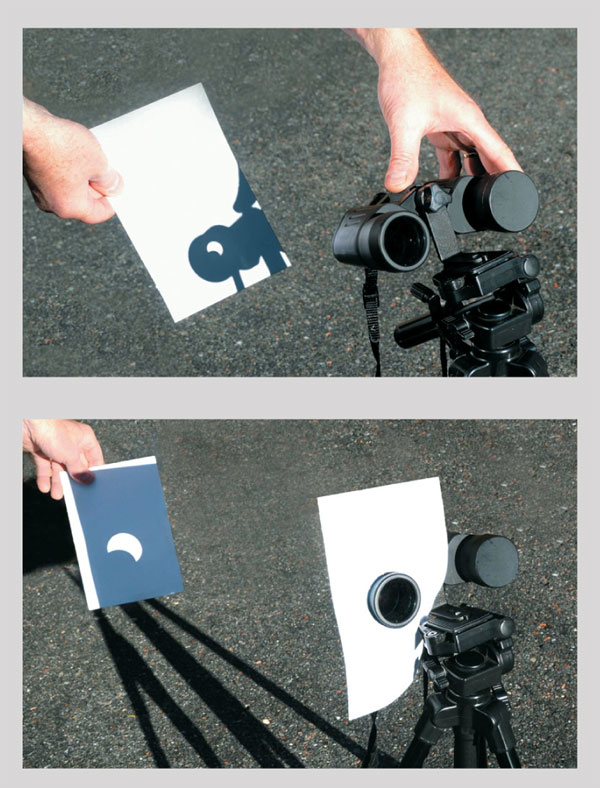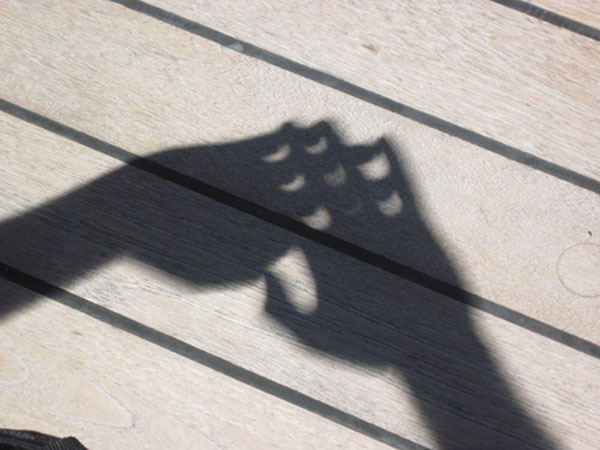Totality watchers get the best show, but far more people will be in partial-only territory. Here’s how to make the most of it.

We’ve had a lot to say about America’s total eclipse of the Sun coming up April 8th. You can visit our eclipse landing page, and get local maps and predictions as detailed as you want (zoom in). But as the globe below shows, for the vast majority of people in North and Central America the eclipse will be only partial.

Sky & Telescope. Source: Fred Espenak
Here are ways to make the most of it — without endangering your eyes.
How to Watch
The blindingly brilliant surface of the Sun can be actually blinding, perhaps permanently, if you stare at it for any length of time. That also goes for the bright part of a partially eclipsed Sun.
You have two basic ways to watch safely: directly through a safe solar filter, or indirectly by projection.
Direct viewing
For this you’ll need a filter that’s specifically designed for Sun viewing: one that reduces the Sun’s invisible infrared and ultraviolet rays as much as it does visible light. All of the inexpensive little “eclipse glasses” that we’ve tested do fine, but to be surest, look for “ISO 12312-2” printed on them. Check the AAS safe vendor guidelines to ensure your eclipse glasses aren't fakes.
For binoculars or telescopes, you can buy solar-filter material made of glass or thin, metal-coated Mylar film — either as a sheet you can cut with scissors to attach over the front of your optics, or pre-mounted in a cell sized to fit firmly onto the front (don’t let it blow off!). Leave the film slack; wrinkles don’t matter, but stretching it will haze out the view and compromise safety. When we tested various glass and thin-film solar filters few years back, we liked Baader Astro-Solar thin film the best.
Projection

Sky & Telescope
Projection means projecting an image of the Sun onto a piece of white paper and watching the paper. The oldest, simplest, but poorest projection method is to use a pinhole. For instance, take a long box, cut a hole in one end, tape aluminum foil over the hole, and put a largish pinhole in the foil. Tape white paper inside the other end of the box, close it up, and cut a big hole in the side of the box so you can look at the paper. Aim the pinhole at the Sun, and an image of the Sun’s face will fall on the paper.
But the image will be very small and dim. Experiment with different sized pinholes. A large one makes the image bright but fuzzy; a small one makes it sharp but dim.
Much better is to use binoculars or a telescope to project a big, bright image, as shown above. Aim the instrument at the Sun (without looking through it! Move it around until its shadow is minimized and light floods out of the eyepiece.) On a telescope, use your lowest-power eyepiece. Focus the image with the focus knob and/or by moving the paper catching the image closer or farther back. If the scope’s aperture is larger than about 3 inches, cut a clean, 3-inch hole in thin cardboard and tape it over the front. You don’t want to let a damaging amount of solar heat inside.
What To Watch For
● Can you see any sunspots? Quite likely! The Sun is currently getting close to the maximum of its 11-year activity cycle, so its face these days is often marked. Any spots will be landmarks for events coming up. If you’re projecting the Sun’s image onto paper, wiggle the paper to make sunspots stand out from subtle paper flaws.
● First contact is the moment when the edge of the Moon first touches the Sun’s western edge. Find the exact time of this event for your location by clicking on this Google Map. But the Moon’s edge will take a little while after first contact to intrude enough to begin to show. How well can you time when this happens? What’s the delay as seen with your setup? Set your timepiece to the second beforehand.
● As the Moon leisurely intrudes farther onto the Sun, look for irregularities showing up on the edge of the Moon’s silhouette. These are lunar mountains and valleys seen in profile along the Moon’s limb. The Sun’s own edge, by contrast, is perfectly smooth.
● Keep an eye on those sunspots. If the black lunar silhouette approaches a big one, and if you’re looking through a fairly large filtered scope, you should be able to see that, by comparison, the sunspot’s dark umbra is not truly dark. Photos to the contrary, sunspot umbras shine with about 20% the surface brightness of the rest of the Sun. They would appear blindingly brilliant if the rest of the Sun weren’t there and dictating the density of your solar filter.
● As the eclipse progresses, look around at the landscape and blue sky. Is the blue becoming deeper and purer? You may be surprised by how much sunlight has to be lost before the world looks any different. This is a measure of how well our eyes naturally adapt to changing lighting conditions.
If the partial eclipse at your site is deep and the Sun becomes a thin crescent, watch for the landscape to take on a slightly alien, silvery look, with shadows turning crisper than usual.
● How deep will the eclipse become at your location? The Google Map tells this two ways. The maximum magnitude of the partial eclipse is the percent of the Sun’s diameter that the Moon will cover. The obscuration tells what fraction of the Sun’s surface area is covered. That’s also about how much light is lost (although the Sun’s disk is a little dimmer around its edges than near its middle, a solar-atmosphere effect called limb darkening).
● Venus and Jupiter will become visible if the sky turns a deep enough blue. Venus is your first try. Look for it 15° (about 1½ fists at arm’s length) to the Sun’s celestial west-southwest. Next brightest is Jupiter, twice as far on the Sun's opposite side. They're magnitudes −3.8 and −2.1.
Unless the eclipse for you becomes total or nearly so, you don’t have much hope for Mars and Saturn, both magnitude +1.2. They're paired 1½° apart 20° beyond Venus in the exact same direction. And forget Mercury; it's close to inferior conjunction and only 4th magnitude (6° to the Sun’s northeast).
● Look for dim dapples of sunlight on the ground under trees. A leaf canopy can form many pinhole projectors, and during a partial eclipse each dapple on the ground will show an identical dent. Or make little holes between the fingers of your two hands laid across each other, as shown in the photo below.

J. Kelly Beatty
And then watch everything slowly unwind in reverse, until the Moon’s last trace slides off eastward into invisibility, and last contact ends the show until next time.
The Next One
And when is the next one?
The next North American partial eclipse happens for Canada and the northeastern U.S. on August 12, 2026. Next, a slight partial eclipse comes to eastern Canada and the eastern U.S. on the morning of January 26, 2028. Then the whole continent will get a partial eclipse on January 14, 2029.
The next total solar eclipse that crosses North America won't happen until August 12, 2045. Totality that day will run from northern California across the U.S. to Florida.
That's a long wait. But if you're willing to travel, the next total eclipse of the Sun anywhere comes on August 12, 2026. That day the umbra of the Moon's shadow will pass over parts of Greenland, Iceland and the Atlantic to clip the northwesternmost corner of Spain and Portugal around sunset.
Find more information and resources for the 2024 solar eclipse.
 0
0









Comments
You must be logged in to post a comment.